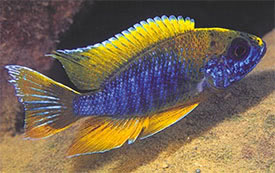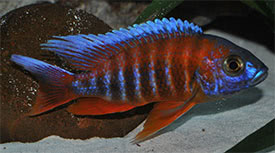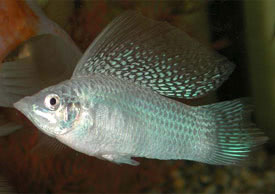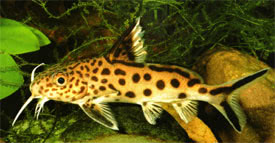
 Magyarul / Hungarian
Magyarul / Hungarian




- Scientific name: Aulonocara jacobfreibergi
- Synonyms: Trematocranus jacobfreibergi
- Common name: Butterfly Peacock, Fairy cichlid, African Butterfly Peacock
- Group: Cichlids
- Habitat: Africa; Lake Malawi, Nkudzi, Monkey Bay, Nankumba, Domwe Islands, Otter Point
- Size: 15-20 cm
- Biotope: Found in the intermediate zones, where the sand bordering the rocky reef and males occupy smaller or larger caves and crevices.
- Social behavior: Not as peaceful as some of its congeners and males tend to react aggressively any fish with a similar colour pattern, so they should be kept in a species tank.
- Diet: Carnivorous; It will take all kind of live, frozen and dried foods. Feeds the same way as the South American Geophagus species: mouthfuls of substrate are taken and sifted for edible foods and the remaining material expelled via the gills and mouth.
- Breeding: Quite easy
- Tank: Minimum 200 litres
- Population: 1 male and 4-6 females for 250 litres
- Decoration: Use rocks to construct structures and caves. but leave some open space between them. Use sand as substrate. The fish will not harm plants so, add tough plants that can tolerate hard water (Anubias).
- Temperature: 25-29 °C
- pH: 7.5-9
- Hardness: 9-19 NK°
- Lifespan: 8-10 years
Description: This was one of the first Aulonocara spp. to enter the hobby and its popularity has endured. The African Butterfly Peacock cichlids are quite variable in size and color pattern depending on the location they originate from. Male has blue color throughout head, body and fins. Upper part of dorsal region is orange or red. Anal fin may show some red coloration. There are also a number of selectively-bred ornamental forms including Eureka and Albino. It can be told apart from most other members of the genus by the broad, pale distal margins in the dorsal, anal and caudal fins, more deeply-forked caudal fin and larger adult size. The females have a silvery grayish-brown body coloring topoped with gray or brown vertical bands. They have a rounded anal and dorsal fin which can be faintly colored. It is important that Aulonocara jacobfreibergi should not be kept with other Aulonocara species, as they may hybridise. Peacock cichlids have special sensory pores on their jaws that help them locate the crustaceans in the sand.
Aulonocara jacobfreibergi "Eureka": It is a naturally occurring strain that grows to 15 cm, and the Eureka Red Peacock is a captive bred color form of this fish. Most of the body is blue with some orange at the top of the head, and along the back. The dorsal fin and caudal fins are light blue, while the anal and pelvic fins are orange. The egg spots on the anal fin are often invisible. The female is very drab with gray and brown vertical bars. The anal fin is rounded with a light gold coloring in the front and white near the back. The pelvic fins are also light gold.
Aulonocara jacobfreibergi "Eureka albino": It is one of the smaller strains with the size of 10-15 cm. Its back, anal and pectoral fins are orange, while the head and the lower part of the body is white. There are no egg spots on the anal fin. The dorsal fin has a little tangerine at the base, but the rest is light blue. The tips of the caudal fin is also blue. Females are basically white and both sexes have yellow eyes with orange pupils.
Aulonocara jacobfreibergi "Undu Reef": It is a naturally occurring strain where the males can reach 18 cm in length, but the females are only 13 cm long. Its base color is bluish with a vertical yellow band just behind the gill cover. The dorsal, anal and pelvic fins are all yellow with no eggspots on anal fin. The tail fin is a mix of blue and yellow.
Aulonocara jacobfreibergi "Otter Point": It is a naturally occurring strain that grows to 15 cm and its body color has a combination of electric blue and orangish red with faint blue vertical bands. The top of the head and the back is orange. The tail fin has a mix of blue and orange and the tip of the fin is blue. The dorsal fin is blue, and the base of the fin is golden. The anal fin is orange and there are no egg spots on it. The female has alternating vertical bars of light brown and white, and its eye is yellow. The anal fin is orange and rounded and the pelvic fin is also orange with blue tip.
Water quality is the most important issue for them, as they are extremely susceptible to bad water conditions, so never introduce these cichlids to a biologically immature tank. The weekly water changes and an over-filtered aquarium is advisable.
Males are larger and more colorful than females. Fairy cichlid is maternal mouthbrooder. They should be spawn in a harem in a separated tank, with at least 4 females to 1 male, as the male can be aggressive in pursuit of females. Put some flat rocks to the tank, and leave open areas of sand to act as potential spawning sites. Before spawning the male will choose a spawning site and begin to display around it. This is where the females will lay their eggs and then pick them up in their mouths. The male has egg-shaped spots on his anal fin and the female is attracted to these. When she tries to add them to the brood in her mouth she actually recieves sperm from the male, thus fertilising the eggs. The female will carry brood for up to 21-28 days before releasing fully free swimming fry. During this time the female will not eat. A stressed female may spit the fry prematurely, so they should be raised in a separated tank. The fry can be fed with small live foods, such as brine shrimp nauplii. They are sexually mature around 12 - 14 months old.
























